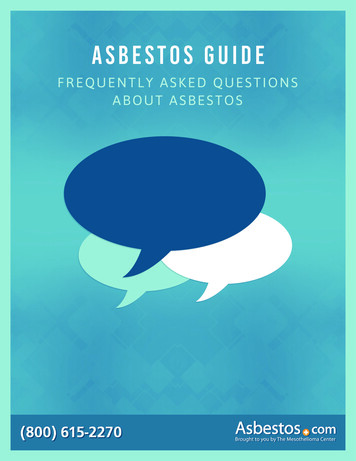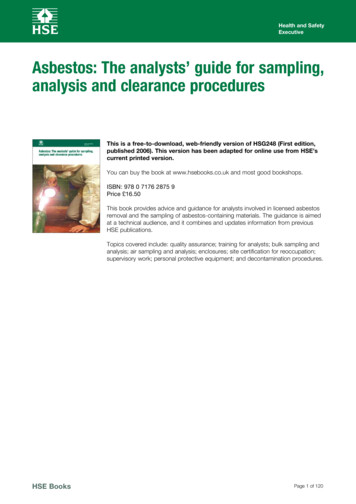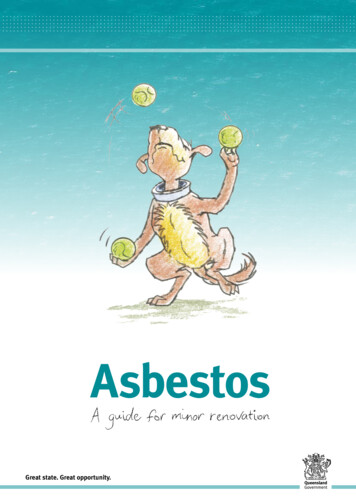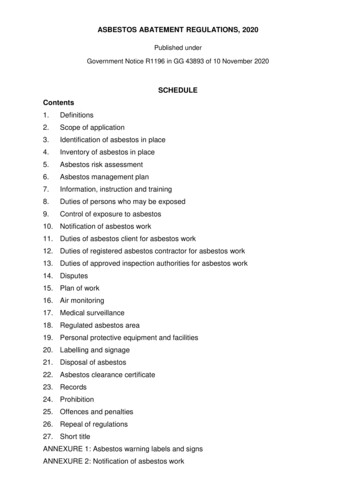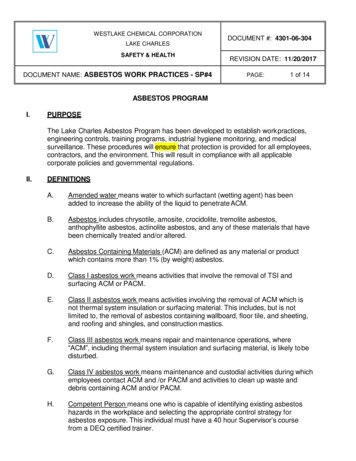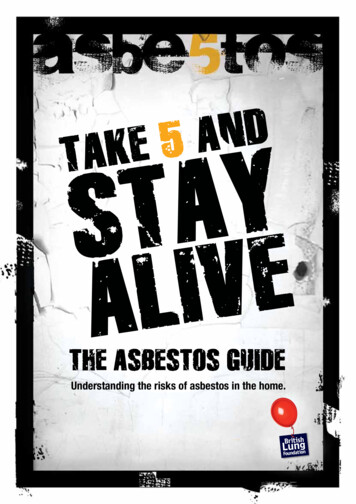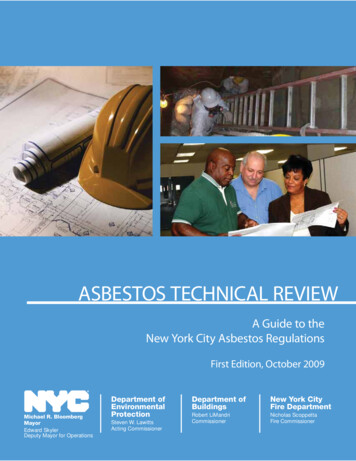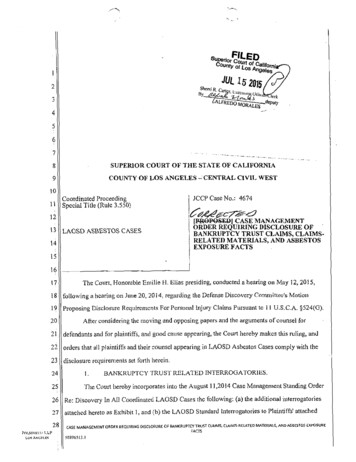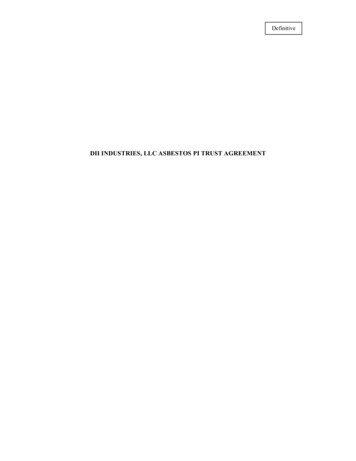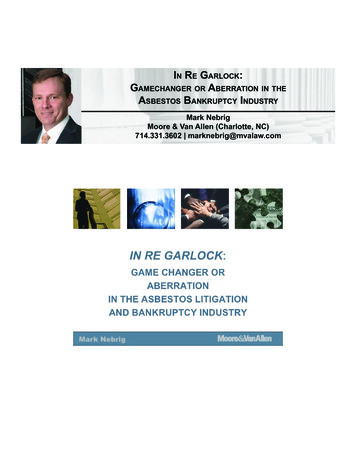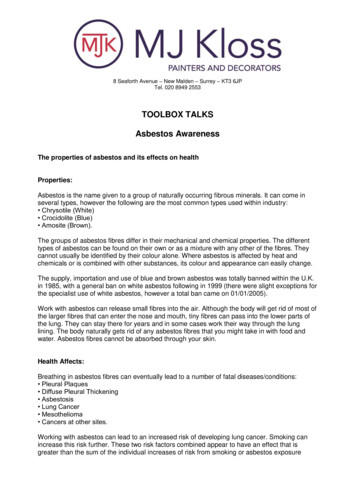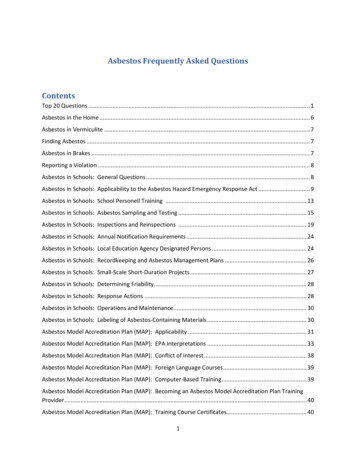
Transcription
CHAPTER 3434ASBESTOSASBESTOSWhere is it Found?Most structures built between 1930 and 1975 willcontain products having substantial amounts ofasbestos. (See Table 34-1 and Figures 34-1, 34-2, and34-3 on the next few pages.)Table 1: Asbestos Products in onalSprayed-On FireproofingXX*Pipe and Boiler InsulationXXLoose Fill InsulationX**Asbestos Cement ProductsXXAcoustical PlasterXXAcoustical TilesXXXVinyl AsbestosXXGaskets XRoofing FeltsXXAsphalt/Asbestos Limpet SprayDrywall Joint-Filling CompoundXXCoatings and MasticsXXThis chapter provides some brief information aboutasbestos in construction. If you encounter asbestoson the job, you will need more information. Hereare the two main sources of further information onasbestos in Ontario construction:XXXXXXXXX*Denotes extensive use. **Vermiculite insulation.xx – May contain vermiculite.If you have any concerns about material that youbelieve may be asbestos, have it checked beforework is started. Otherwise, treat the material as if itis asbestos.The legal requirements for handling, working with,removing, and disposing of asbestos and asbestoscontaining products are described in DesignatedSubstance—Asbestos on Construction Projectsand in Buildings and Repair Operations (OntarioRegulation 278/05). Read the regulation to get a fulldescription of your legal duties. You can get a copyfrom IHSA or read it on our website (www.ihsa.ca).Asbestos is a "designated substance" underOntario health and safety legislation. This meanthat its exposure is prohibited, regulated, restricted,limited, or controlled. Owners must notifycontractors of the presence of any designatedsubstances on a project before work begins ortenders are submitted. Contractors also have aresponsibility to advise subcontractors.In addition, IHSA publishes Asbestos: Controlsfor Construction, Renovation, and Demolition(DS037). It contains more information than what’sin this chapter, and it tells you how to protectyourself. It can also help you understand theasbestos regulation. You can order a copy fromIHSA or download it from our website.IHSA has developed a guide for creating thisnotification report. Owner’s Duties: DesignatedSubstances on Construction Projects (W130) isavailable to download for free from our website. Itis also available in French (W130F).What is Asbestos?Workers in the carpentry, plumbing, heating andair conditioning, drywall, resilient flooring, andacoustic and interior systems trades may encounterasbestos inAsbestos is a naturally occurring material onceused widely in the construction industry. Itsstrength, ability to withstand high temperatures,and resistance to many chemicals made it useful inhundreds of applications.-- light fixtures-- light troughs-- soffits-- transite tile over stairways-- soffits of plazas-- ceiling tile-- 2’ x 2’ porous tile-- exterior cladding-- insulation (wall and heating pipe)-- drywall joint compound (pre-1980)-- caulking materials-- gaskets and packings.But asbestos can also kill. When inhaled, asbestoshas been shown to cause the following diseases Asbestosis Lung cancer Mesothelioma (cancer of the lining of the chestand/or abdomen).The early widespread use of asbestos has left apotentially dangerous legacy. Many older buildingshave asbestos-containing materials (ACM) invarious forms and in various states or conditionsthat can cause exposure to workers or occupants.Sanding or machine cutting creates fine airbornedust, which may stay airborne for 24 hours orlonger. Air movements created by heating and airconditioning systems will spread these airbornefibre particles throughout the building unless thework area and ductwork is sealed off.The improper handling of asbestos-containingproducts can release harmful amounts of asbestosfibre into the air.HazardsIndustrial34-1
ASBESTOSFigure 34-1: Asbestos Products and Locations in Commercial/Institutional BuildingsFigure 34-2: Asbestos Products and Locations in Industrial Work34-2Construction Health and Safety Manual
ASBESTOSFigure 34-3: Asbestos Products in Residential BuildingsHazards34-3
ASBESTOSClasses of AsbestosCertification and TrainingTwo classes of asbestos products were widelyused in the past. The first includes materials easilycrumbled or loose in composition. These arereferred to as “friable.”Whenever work is planned at a location whereasbestos is present, constructors and employersmust inform workers about The location of asbestos-containing materials ormaterials assumed to contain asbestosThe second type includes materials much moredurable because they are held together by a bindersuch as cement, vinyl, or asphalt. These products aretermed “non-friable.” Whether the material is friable or non-friable, andFriable material was widely used to fireproof steelstructures. It can be found on beams, columns,trusses, hoists, and steel pan floors. Sprayedmaterial was also used as a decorative finish and asacoustical insulation on ceilings.The material can beloose, fluffy, andlumpy in texture or,if more gypsumwas used, it may bequite hard anddurable.Friable Materials The type of asbestos (e.g., chrysotile, amosite,tremolite, etc.) if the material is sprayed.Constructors and employers must then ensurethat workers are trained on asbestos hazards andcontrols as detailed in this section.Employers performing regular service or maintenancework on behalf of owners have these same trainingrequirements. Such employers should developsafe work practices. They should also becomefamiliar with the owner’s asbestos procedures andcommunicate them to their employees.Certification: Type 3 OperationsApproved FireproofingAll workers who perform Type 3 asbestosoperations—and the supervisors of these workers—must be certified to do their work. (Type 3operations are discussed later in this chapter.)This certification requirement is containedin Ontario Regulation 278/05. There are twocertification programs: one for workers and one forsupervisors. Supervisors must complete both theworker program and the supervisor program.Acoustical CoatingSprayed FireproofingThe certification programs must comply withthe training standards of the Ministry of Training,Colleges, and Universities (MTCU). IHSA's AsbestosAbatement Supervisor and Asbestos AbatementWorker courses meet the MTCU standard andqualify participants to take the MTCU certificationtests.Air-Cell Pipe InsulationNon-Friable MaterialsSuspended Ceiling Concealing FireproofingAsbestos-Cement SidingVinyl Asbestos Floor Tile34-4Construction Health and Safety Manual
ASBESTOSTraining for any “Type” of Asbestos OperationEncapsulation or RemovalWorkers in any “Type” of asbestos operation—aswell as other workers who could be exposed toasbestos—must be trained by a competent personon the following:In dealing with asbestos that may be encounteredin applications such as fireproofing and cement, thedecision whether to encapsulate the material, removeit, or leave it in place rests with the client/owner. The hazards of asbestos exposure Personal hygiene and correct procedures for workwith asbestosMany owners of asbestos-containing buildingshave decided to reduce the risk of exposure toasbestos. The procedure is normally either removalor encapsulation. Encapsulation means sprayingan approved sealant onto or into the material orprotecting it with an impervious cover to prevent therelease of fibres into the air in the building. How to use, clean, and dispose of protectiveclothing.Encapsulation is permitted only if the asbestos willnot be damaged further in the process.Note: The above applies to facility owners andtenants whose employees undertake work involvingthe removal or disturbance of asbestos-containingmaterial or who contract with other employers todo so.Removal of asbestos is a more permanent solutionto the problem. Most removal projects employ thewet removal method. Water and a wetting agentare sprayed onto the asbestos. This effectivelyreduces the quantity of fibres released when thematerial is removed. The purpose, inspection, maintenance, use,fitting, cleaning, disinfecting, and limitations ofrespiratorsTraining should also includeDry removal is normally done only when wet removalis unsafe or impractical—for instance in computerrooms or other areas where there is a chance ofwater damage to delicate equipment. Dry removalcauses excessively high concentrations of asbestosfibres (in excess of 100 fibres per cubic centimetre)and may contaminate other previously “clean” areas. Methods of recognizing asbestos, includingidentification of building materials that containasbestos The relationship between smoking, asbestos, andlung cancer The kinds of operations that could result inexposure to asbestosDuring dry removal projects, use an extensivefiltered exhaust system to create a slight negativeair pressure in the work area. This will reducethe chance of spreading asbestos fibres. Therequirements for negative air pressure are specifiedin the asbestos regulation. Classification of Type 1, Type 2, and Type 3operations Required work procedures and controls tominimize exposure, including engineeringcontrols, work practices, respirators,housekeeping procedures, hygiene facilities,protective clothing, decontamination procedures,emergency procedures, and waste disposalproceduresAnother solution is to enclose the asbestos with aphysical barrier such as drywall. This is normally donewhere the area is not going to be entered frequentlyor altered later. The requirements of the medical-surveillanceprogramThe asbestos regulation specifies what precautionsmust be taken during removal, encapsulation, orenclosure. The requirements for signs and labels.The Joint Health and Safety Committee or theHealth and Safety Representative must be informedabout when and where the training will take place.Figure 34-4: Spraying ACM withAmended Water Before Wet RemovalHazards34-5
ASBESTOSTypes of Asbestos OperationsType 1 OperationsUnder Ontario law, asbestos operations are classifiedas Type 1, Type 2, or Type 3.Type 1 operations include the following:1) Installing or removing less than 7.5 squaremetres of ceiling tile containing asbestos (81square feet, or ten 4-foot x 2-foot ceiling tiles)without it being broken, cut, drilled, abraded,ground, sanded, or vibrated.Type 1 – generally presents minimal hazard toworkers or bystanders (for example, handremoval of vinyl asbestos tile).Type 2 – may create exposure exceedingacceptable limits (e.g., removing six squareinches of asbestos fireproofing to attach anew pipe hanger).2) Installing or removing non-friable asbestoscontaining material, other than ceiling tiles,without it being broken, cut, drilled, abraded,ground, sanded, or vibrated.Type 3 – major exposures—exceeding acceptablelimits—involving frequent or prolongedexposure, and posing serious risks to bothworkers and to bystanders (e.g., full-scaleremoval of sprayed asbestos fireproofingin an occupied building).3) Breaking, cutting, drilling, abrading, grinding,sanding, or vibrating non-friable asbestoscontaining material ifa) you wet the material, andb) you use only non-powered hand-held tools.Ontario Regulation 278/05 (Designated Substance—Asbestos on Construction Projects and in Buildingsand Repair Operations) outlines safe work proceduresand respiratory protection for workers who mayencounter asbestos in the course of their work. IHSAproduces a manual called Asbestos: Controls forConstruction, Renovation, and Demolition (DS037).It shows how workers can protect themselves anddescribes correct procedures for asbestos operations.It also helps employers and constructors understandtheir legal responsibilities.4) Removing less than one square metre ofdrywall where asbestos joint-filling compoundwas used.If these operations are done properly, it is unlikelythat exposure will exceed acceptable limits(Figures 34-5, 34-6, and 34-7).See the respirator selection chart at the end of thechapter to determine the respirator you require.You must also follow the control proceduresdescribed in Regulation 278/05. See IHSA’sasbestos manual (DS037) for details.Wetting agentWater alone is not sufficient to control dust andfibres. You must add a “wetting agent” to reducethe water’s surface tension. This increases thewater’s ability to penetrate material and get intonooks and crannies.To make this “amended water,” you can useordinary dishwashing detergent: 1 cup detergentfor every 20 litres of water.Figure 34-5: Hand Sawing Asbestos Cement PipeFigure 34-7: Scribing andBreaking Asbestos CementFigure 34-6: Using Manual Pipe Cutter34-6Construction Health and Safety Manual
ASBESTOSType 2 OperationsDrywall joint-filling compoundExposure to asbestos is likely in Type 2 operations. Youneed controls to protect workers and others nearby.Early drywall joint-filling compounds containedsignificant amounts of asbestos fibre. Thisparticular use was specifically prohibited in 1980.Still, it may be found in buildings constructedseveral years afterwards.Type 2 operations include the following:1) Removing all or part of a false ceiling in buildingscontaining sprayed asbestos fireproofing if itis likely that asbestos dust is resting on top ofthe ceiling (Figure 34-8). This is likely whenfireproofing is deteriorating or damaged.8) Working on non-friable asbestos with powertools that are attached to dust-collecting devicesequipped with HEPA filters (Figure 34-9). If youneed to power-grind or to machine the asbestosproduct and your tools are not equipped withHEPA-filtered dust collectors, refer to IHSA’sAsbestos: Controls for Construction, Renovation,Demolition, Section 12.9.To prevent electric shock, any power tools usedaround water must be equipped with a ground faultcircuit interrupter (GFCI) and be maintained properly.Figure 34-8: Type 2 Operation—Removing Asbestos Dust from Ceiling2) Removing or disturbing less than 1 square metreof friable asbestos materials—for example,repairing an insulated pipe joint or removingsome fireproofing to fasten a new pipe hanger.3) Enclosing friable asbestos insulation to preventfurther damage or deterioration.4) Applying tape, sealant, or other covering (bymeans other than spraying) to pipe or boilerinsulation.Figure 34-9: Type 2 Operation—Using Dust Collector with HEPA FIlter5) Installing or removing more than 7.5 squaremetres of ceiling tile containing asbestos,without it being broken, cut, drilled, abraded,ground, sanded, or vibrated.9) Using a glove bag to remove asbestoscontaining materials from pipes, ducts, orsimilar structures.10) Cleaning or removing filters used in air-handlingequipment in a building with sprayed asbestosfireproofing.6) Breaking, cutting, drilling, abrading, grinding,sanding, or vibrating non-friable asbestoscontaining material if the material is not wettedand the work is done only with non-poweredhand-held tools.11) An operation that is not Type 1 or Type 3.7) Removing one square metre or more of drywallwhere the joint-filling compound contains asbestos.HazardsSee the respirator selection chart at the end of thechapter to determine the respirator you require.You must also follow the control proceduresdescribed in Regulation 278/05. See IHSA’sasbestos manual (DS037) for details.34-7
ASBESTOSType 3 OperationsAsbestos Waste ManagementThese operations require the most precautionsbecause they can release substantial amounts ofasbestos dust (Figure 34-10).The off-site handling and disposal of asbestoswaste is governed by the Environmental ProtectionAct. Regulations regarding the transportation ofdangerous goods under either Transport Canada(federal) or the Ontario Ministry of Transportationmay also apply.Every worker and supervisor involved in a Type 3operation must be certified to do their work. Seethe section on “Certification and Training” earlier inthis chapter.1) Removing or disturbing more than 1 squaremetre of friable asbestos-containing material.Some municipalities may not accept asbestoswaste at landfill operations. Contractors are urgedto check with local authorities for the nearestdisposal site and with the district office of theMinistry of the Environment.2) Spraying a sealant onto friable asbestosmaterial.Equivalent Measures and ProceduresType 3 operations include the following:3) Cleaning or removing air-handling equipment inbuildings with sprayed asbestos fireproofing.4) Repair, alteration, or demolition of kilns,metallurgical furnaces, and other installationswith asbestos refractory materials.5) Disturbing non-friable asbestos material in anyway with power tools not equipped with dustcollectors and HEPA vacuums.A contractor may use measures and proceduresother than those described in this chapter if theproposed measures and procedures offer the sameor better protection for workers.A written notice of this variance must be given inadvance to the joint health and safety committeeor the health and safety representative for theworkplace.6) Repair, alteration, or demolition of buildingswhich are or were used to manufactureasbestos products unless the asbestos wascleaned up and removed before March 16, 1986.See the respirator selection chart at the end of thechapter to determine the respirator you require.You must also follow the control proceduresdescribed in Regulation 278/05. See IHSA’sasbestos manual (DS037) for details.Figure 34-10: Typical Entry/Decontamination Layout for Type 3 Operations34-8Construction Health and Safety Manual
ASBESTOSHazards34-9
describes correct procedures for asbestos operations. It also helps employers and constructors understand their legal responsibilities. Figure 34-5: Hand Sawing Asbestos Cement Pipe Figure 34-6: Using Manual Pipe Cutter Type 1 Operations Type 1 operations include the following: 1) Installing or removing less than 7.5 square
